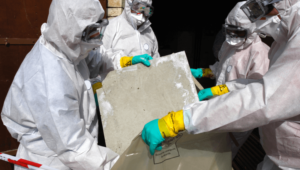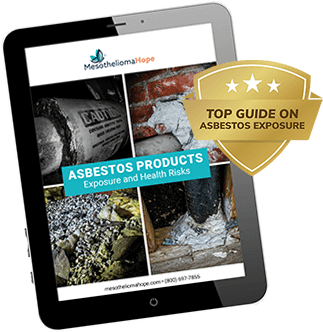Widespread Use of Products Containing Asbestos
Asbestos showed up in products everywhere — from drug store cosmetics to Navy ship insulation — before its dangers were widely known.

It’s estimated that 27 million Americans were exposed to asbestos products during the 20th century.
Asbestos had many benefits that made it useful in a wide variety of products. It was hailed as a so-called “miracle mineral” for decades.
It was also chemically inert so product manufacturers could blend its fibers into all sorts of different materials without a chemical reaction.
Asbestos products were used to make:
- Aircraft parts
- Automotive parts
- Building materials
- Consumer products
- Heavy equipment parts
- Ships
However, asbestos had a major drawback. When inhaled, its fibers never leave the human body and can cause life-threatening diseases like asbestosis, lung cancer, and mesothelioma.
Why Were Asbestos Products Used?
Asbestos products were used because the wide-ranging benefits of the mineral outweighed its deadly drawbacks.
Learn more about some of the benefits below.
-
Durability
Asbestos was exceptionally strong and made products more durable.
-
Fire Resistance
Asbestos products were desirable in high-heat and high-combustion settings since they could withstand high temperatures. Asbestos liners in boilers, stoves, and fireboxes controlled heat in amazing ways.
-
Friction Resistance
Automotive assemblers found asbestos resisted friction and wear. Automobile makers manufactured brakes, clutches, and gaskets from asbestos. Almost every American car, truck, and piece of heavy equipment contained asbestos parts at one time.
-
Lightweight
Asbestos was so lightweight that it could be used to make airplane parts.
-
Low Cost
Asbestos was relatively cheap to extract from the ground and blend into products. This property allowed manufacturers to make handsome profits.
-
Non-Conductive
Asbestos resisted electricity very well. This made it highly useful as insulation for electrical wiring.
-
Sound Absorption
Shipbuilders found asbestos products perfect because they absorbed sound like no other material yet discovered.
For decades, the only ones who knew of the horrific dangers of asbestos were the manufacturers of asbestos-containing products.
But these manufacturers downplayed and even hid the dangers of asbestos from the general public rather than keeping people safe.
Products That Contain Asbestos
The benefits and natural availability of asbestos resulted in the material being used in hundreds of products from the 1920s until the 1980s — when clear links were made between asbestos exposure and illness.
Below are examples of some common asbestos-containing products.
Automotive Parts
Asbestos was used in the manufacturing of many automobile parts due to its durable and friction-resistant nature.
Asbestos could be found in:
- Brake linings
- Brake pads
- Brake shoes
- Clutch facings
- Gaskets
- Hood liners
Construction Materials
Many construction materials were manufactured with asbestos because the mineral is strong, lightweight, friction- and heat-resistant, and cheap.
These factors made asbestos the perfect material for building long-lasting and sustainable structures.
Asbestos could be found in these construction materials:
- Cement pipe
- Cement powder/mortar mixes
- Drywall
- Ducts
- Electrical components
- Gaskets
- Hoses
- HVAC systems
- Insulation
- Joint compound
- Pipes and blockwork
- Protective clothing
- Tiles
- Valves
Because of the extent to which asbestos was used to build houses and other structures, construction workers face a high risk of asbestos exposure.
Asbestos was also found in dozens of other industrial and consumer products.
Talc & Baby Powder
Talc is a mineral that helps absorb moisture and reduce friction. These qualities make it a perfect additive in baby powder, talcum powder, makeup, and other consumer goods.
However, talc and asbestos deposits are often located near each other, which means it is possible for a supply of talc to be contaminated with asbestos.
In October 2019, the U.S. Food and Drug Administration (FDA) a dvised consumers to stop purchasing Johnson & Johnson’s famous baby powder.
This alert came after the agency found trace amounts of asbestos in samples of the company’s baby powder.
Johnson & Johnson has since stopped selling talc-based baby powder in the U.S. and Canada and said it plans to transition to a cornstarch-based product worldwide.
Asbestos in talc-based powder has been linked to ovarian cancer, mesothelioma, and other health issues.
Currently, Johnson & Johnson is facing tens of thousands of talcum powder lawsuits filed by plaintiffs who say the company failed to warn of dangers related to its products.
Tiles
Asbestos was commonly used in the manufacturing of various types of tiles found in commercial buildings, military barracks, and even residential homes.
Though asbestos tiles are sealed with a protective coating, the dangerous fibers can still be dispersed into the air if the tiles are cut or damaged.
Asbestos was used in the following types of tiles:
- Bathroom tiles
- Ceiling tiles
- Kitchen tiles
- Vinyl floor tiles
Proper safety precautions should be taken to avoid inhalation of hazardous asbestos fibers when replacing tiles in older homes.
Other Asbestos Products
In addition to the products listed above, asbestos was also used in hundreds of other products.
Manufacturers could cut down on costs since asbestos was so cheap and still create durable and lightweight products.
Other asbestos-containing products included:
- Air-conditioning systems
- Adhesives
- Caulking
- Cigarette filters
- Fireproofing
- Fire blankets
- Fertilizer
- Hairdryers
- Heaters
- Makeup
- Millboard
- Paint
- Patching
- Potting soil
- Putty
- Roofing and shingles
- Sealants
- Textiles
- Toothpaste
- Wallboard
Asbestos is dangerous despite its positive properties. The material has been linked to various forms of cancerous and non-cancerous diseases.
Diseases Caused by Asbestos Exposure
Anyone who used the asbestos-containing products listed above, as well as others not on the list, could be at risk of several serious illnesses.


Microscopic asbestos fibers can be released into the air when asbestos-based products get disturbed. People can then inhale or swallow these fibers.
Asbestos fibers are so durable that the human body cannot break them down.
Over time, the asbestos fibers irritate healthy tissue and eventually cause the affected person to get sick. This causes asbestos related diseases to form.
The most common diseases related to asbestos products are:
- Asbestosis: benign (non-cancerous) scar tissue in the lungs
- Lung cancer: malignant (cancerous) tumors grow inside the lung
- Mesothelioma: cancer masses develop in the lung, heart, abdomen, and testicle linings
- Other cancers: asbestos-related cancer can develop in the ovaries and larynx
Other conditions related to asbestos — such as pleural plaques, pleural effusion, and pleural thickening — are not life-threatening, but most are uncomfortable.
Asbestos-related diseases affect thousands of people each year.
Approximately 3,000 people are diagnosed with mesothelioma in the U.S. each year, according to the American Society of Clinical Oncology (ASCO).
Anyone with an asbestos-related disease should explore their treatment options and how to pay for their medical expenses. Our Free Asbestos Products Guide can help you get started.
Banning Asbestos Products
Many health authorities are trying to ban products with asbestos from being made or sold to prevent more people from getting sick and dying.
U.S. federal government regulators started taking steps in the late 1970s to control products containing asbestos.
That included regulatory agencies such as:
- Environmental Protection Agency (EPA)
- Department of Labor’s Occupational Safety & Health Administration (OSHA)
- U.S. Consumer Product Safety Commission (CPSC)
Authorities had successfully banned some asbestos products by the late 1980s, but they have not totally banned the mineral in the United States as of 2022.
Friable (easily crumbled) asbestos products present the highest exposure danger. They are expressly prohibited for sale or use.
Examples of banned asbestos products include:
- Commercial paper
- Flooring and roofing felt
- Fireplace embers
- Pipe and block insulation
- Rollboard
- Specialty paper
- Spray-applied asbestos
- Wall patch compounds
United States asbestos legislation permits other asbestos products if they contain less than 1% asbestos material. Regardless, most medical authorities state that there is no such thing as a safe exposure to asbestos.
It’s also illegal to manufacture “new use” products that didn’t previously contain asbestos.
The three U.S. laws affecting asbestos products are:
- Clean Air Act
- Consumer Product Safety Act
- Toxic Substances Control Act
In April 2022, EPA proposed a ban of ongoing uses of asbestos under the Toxic Substances Control Act. If finalized, the ban would prohibit the manufacture, processing, distribution, and use of a type of asbestos known as chrysotile asbestos.
In 2020, the agency, in a Final Risk Evaluation for Asbestos, concluded that chrysotile asbestos poses “unreasonable risks to human health for all ongoing uses of chrysotile asbestos.”
Learn more about the health risks posed by asbestos products in our free guide.
Asbestos Products Today
Asbestos products still pose a threat to human health despite modern restrictions.
Millions of American homes, public buildings, and factories were built with asbestos-containing materials. Most of these still stand today with their asbestos products intact.
The same applies to ships and heavy equipment, although removal programs removed friable asbestos materials.
Federal regulations specify strict steps workers must take to remove or work around asbestos products.
The safest way to approach asbestos products today is assuming they are dangerous and taking the appropriate safety precautions.
Call a licensed professional to remove any asbestos-containing materials. Small samples can be tested in labs to confirm or rule out asbestos contamination before handling them.
Those exposed to asbestos-based products — whether today or decades ago — should also learn if they qualify for financial compensation that can help pay for expenses.
Compensation for Asbestos-Related Diseases
The bottom line is that nobody expected — or deserved — to develop deadly diseases from everyday products.
If you used asbestos-containing products and developed mesothelioma, lung cancer, or asbestosis, you may be entitled to legal help.
This compensation comes from the manufacturers of asbestos-containing products that neglected their duties by putting people like you at risk. Compensation from asbestos trust funds, for example, can help pay for lost income, medical bills, and any other expenses.
The court system has held manufacturers responsible for endangering the public and awarded compensation to victims of asbestos exposure and their families. You may qualify to access compensation as well.
Contact us right now to learn more about your legal options.
Asbestos Products FAQs
What products today contain asbestos?
Today, asbestos is most likely to be found in automotive parts such as clutches, brake shoes, and gaskets.
Additionally, asbestos can be found in older buildings. These buildings often contain asbestos-laden construction materials, including drywall, tiles, roofing, and paint.
Because asbestos-containing products were commonly used in the auto parts and construction industries, mechanics and construction workers are especially at risk of developing asbestos-related diseases.
Which item is most likely to contain asbestos?
Items most likely to contain asbestos are those that were used to construct office buildings, schools, residential homes, and other structures from the 1920s to the 1980s. The older a building is, the more likely that it contains asbestos-laden materials.
Insulation, roofing, drywall, and other construction materials were more often than not laden with asbestos.
Construction workers who handled these materials — or worked near others who did — are at risk of developing mesothelioma and other asbestos-related diseases.
Another area of concern is asbestos in auto parts.
According to EPA, “some, but not all, automotive brakes and clutches available or in use today may contain asbestos.”
OSHA suggests that mechanics “assume that all brakes have asbestos-type shoes” and take appropriate precautions.




